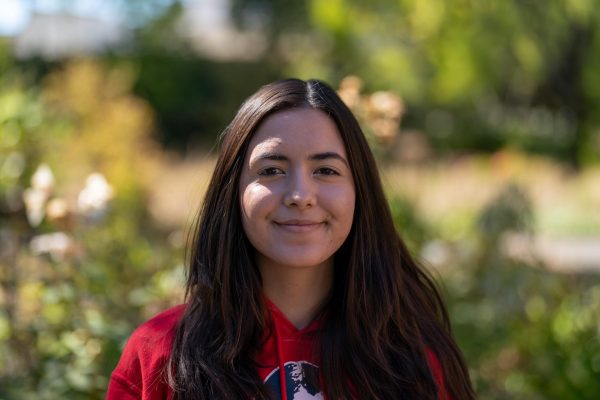Eager students flock to fill the limited spots for the backstrap weaving workshop at 10 a.m. on Sept. 20 at the Santa Rosa Junior College Intercultural Center
Weavers tell stories through their textiles. An example featured an orange blouse with two horses on the side. Sari Monroy, a fiber artisan, shared its story of two lovers who rode horses to meet in secret because their families refused to let them be together.
The loom is double-sided, with threads running from the front to back, creating a space where bamboo wrapped in thread is placed to create another line of the pattern. The top end of the loom uses rope to attach it to a tree to have it hanging 5 feet in the air while the backstrap around the hips is attached to the bottom of the loom.
Wooden sticks were shaped into tools to hold the cotton threads together. At the top and bottom of the loom the thread wraps around the top and bottom beams. The heddle is pulled towards the user’s chest to separate the back threads of the loom from the front, shuttle is the thread passed through to create a new row on the loom, the heddle is used between the threads on the new row the shuttle passed through to ensure its secureness.
Students faced the challenge of body connection to the loom, where they each had to pull their body closer to the loom at a 45 degree angle and pull the heddle to create a gap between the front and back threads, ensuring the threads are separated from one another for the new row.
Monroy spoke about the history of the backstrap. “The loom and many other tools that are part of a weaver’s craft, evolved from this relationship to land,” Monroy said. The materials used are tended to and harvested the plants such as cotton, agave, pericorn, and many others. They were used for the tools, dyes, and thread to create a masterpiece made of nature.
Due to this relationship with the land that provides materials for this craft, clothes made from this technique were so durable that they would become heirlooms passed down for generations before wearing out.
Women primarily practiced this form of weaving, but it wasn’t exclusive to them. Men also practiced this technique, along with the pedal loom, a larger and stationary form of backstrap weaving.
Approximately 12 attendees participated in the session, and each participant received a full backstrap loom, extra thread for designs and videos to encourage continued practice. Without encouragement this practice can be lost due to time. “Remember that backstrap weaving, when connected to the culture, is a powerful connection to ancestral memory. Our textiles are our stories,” Monroy said.





